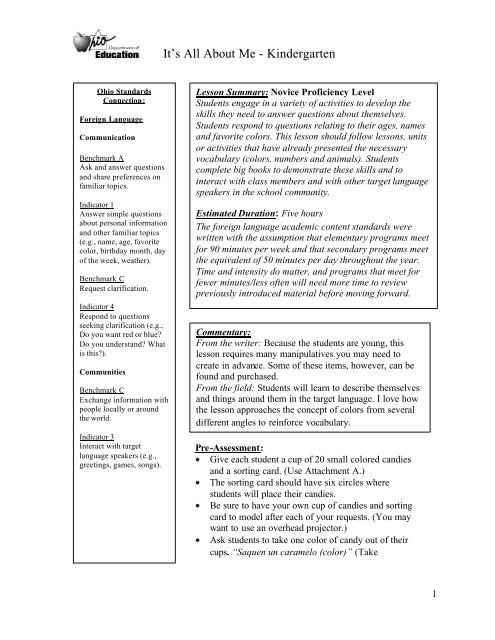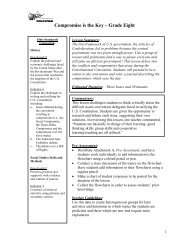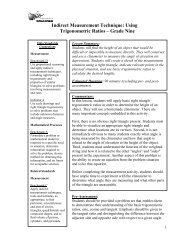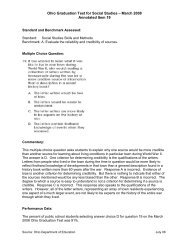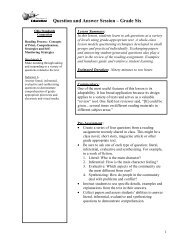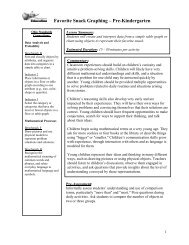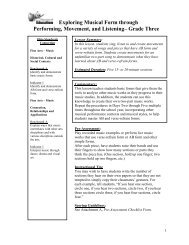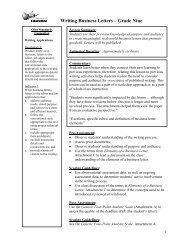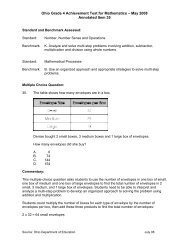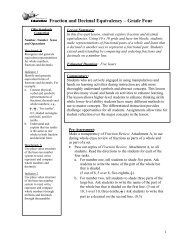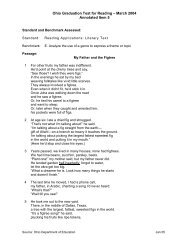It's All About Me - Kindergarten - ODE - Ohio Department of Education
It's All About Me - Kindergarten - ODE - Ohio Department of Education
It's All About Me - Kindergarten - ODE - Ohio Department of Education
Create successful ePaper yourself
Turn your PDF publications into a flip-book with our unique Google optimized e-Paper software.
It’s <strong>All</strong> <strong>About</strong> <strong>Me</strong> - <strong>Kindergarten</strong><strong>Ohio</strong> StandardsConnection:Foreign LanguageCommunicationBenchmark AAsk and answer questionsand share preferences onfamiliar topics.Indicator 1Answer simple questionsabout personal informationand other familiar topics(e.g., name, age, favoritecolor, birthday month, day<strong>of</strong> the week, weather).Benchmark CRequest clarification.Indicator 4Respond to questionsseeking clarification (e.g.,Do you want red or blue?Do you understand? Whatis this?).CommunitiesBenchmark CExchange information withpeople locally or aroundthe world.Indicator 3Interact with targetlanguage speakers (e.g.,greetings, games, songs).Lesson Summary: Novice Pr<strong>of</strong>iciency LevelStudents engage in a variety <strong>of</strong> activities to develop theskills they need to answer questions about themselves.Students respond to questions relating to their ages, namesand favorite colors. This lesson should follow lessons, unitsor activities that have already presented the necessaryvocabulary (colors, numbers and animals). Studentscomplete big books to demonstrate these skills and tointeract with class members and with other target languagespeakers in the school community.Estimated Duration: Five hoursThe foreign language academic content standards werewritten with the assumption that elementary programs meetfor 90 minutes per week and that secondary programs meetthe equivalent <strong>of</strong> 50 minutes per day throughout the year.Time and intensity do matter, and programs that meet forfewer minutes/less <strong>of</strong>ten will need more time to reviewpreviously introduced material before moving forward.Commentary:From the writer: Because the students are young, thislesson requires many manipulatives you may need tocreate in advance. Some <strong>of</strong> these items, however, can befound and purchased.From the field: Students will learn to describe themselvesand things around them in the target language. I love howthe lesson approaches the concept <strong>of</strong> colors from severaldifferent angles to reinforce vocabulary.Pre-Assessment:• Give each student a cup <strong>of</strong> 20 small colored candiesand a sorting card. (Use Attachment A.)• The sorting card should have six circles wherestudents will place their candies.• Be sure to have your own cup <strong>of</strong> candies and sortingcard to model after each <strong>of</strong> your requests. (You maywant to use an overhead projector.)• Ask students to take one color <strong>of</strong> candy out <strong>of</strong> theircups. “Saquen un caramelo (color)” (Take1
It’s <strong>All</strong> <strong>About</strong> <strong>Me</strong> - <strong>Kindergarten</strong>out one (color) candy). Continue this activity until all students have taken out one candy<strong>of</strong> each color.• Ask students to then form a group <strong>of</strong> one particular color and place them in one <strong>of</strong> thecircles on their sorting card. “Formen un grupo de (color)” (Form a group <strong>of</strong> (color)candies). Continue to ask students to separate the candies by forming groups, being sureto ask for each color one at a time. Students should have all candies separated into groupsaccording to color on their sorting cards.• Tell students how many candies <strong>of</strong> each color you have. “Tengo (número) (color)” (Ihave (number <strong>of</strong> color) candies).• Ask students how many candies they have <strong>of</strong> each color. Be sure to ask for one color at atime, calling on three or four students to share per color. “¿Cuántos del color (rojo,anaranjado, amarillo, verde, azul, morado) tienes?” (How many (red, orange, yellow,green, blue, purple) do you have?) Encourage students to respond using “Tengo…” (Ihave…).• Once everyone has had the opportunity to share, you may have students eat their candiesby calling out one color at a time.Instructional Tips:• If you prefer not to use candy in the classroom, you may want to use multicoloredmarkers, beads or chips.• It may be helpful to use an overhead projector to show students how to use the sortingcard. You also may want to use translucent colored game markers on the overhead t<strong>of</strong>urther assist students in identifying and sorting colors.Scoring Guidelines:Keep a checklist while you do this activity. Mark on the checklist whether each student wasable to identify the color and number <strong>of</strong> candies he or she had. If students are not able toidentify the color or number, you may want to <strong>of</strong>fer supporting activities. Some samplesupporting activities may be found in the list <strong>of</strong> extensions for this lesson.Instructional Tip:Class size or time constraints may prevent you from keeping an accurate checklist whereeach individual child is assessed. You may need to assess your students by generalobservation. Did the majority <strong>of</strong> the class understand the directions given? Did the majority<strong>of</strong> the class identify the color correctly and respond when asked to participate? Use theseobservations to guide you on how to approach the lesson with your particular group <strong>of</strong>students.Post-Assessment:Please note that there are two Post-Assessments in this lesson.2
It’s <strong>All</strong> <strong>About</strong> <strong>Me</strong> - <strong>Kindergarten</strong>Part One: Big Books.Have students create big books about themselves with illustrations that encourage them totalk about personal information. Each page will demonstrate a skill they have acquiredthrough the activities in class and serve as a type <strong>of</strong> portfolio.• Distribute one page <strong>of</strong> the book to students to work on after the end <strong>of</strong> each day or untilall students can respond to the questions with ease. Each page should be an extension <strong>of</strong>the skill they acquired in the activity.• The first page should ask students to draw themselves above the printed text “Yo” (me).You may want to do this on the first day <strong>of</strong> the lesson to introduce the topic and to allowthe students to understand “yo.”• The second page should ask students to illustrate how old they are by drawing a number<strong>of</strong> items and writing the number in the box found in the text “ Tengo ___ años.” (I am __years old). For example, if the student is six, that student may choose to draw sixbumblebees or cars.• The third page should ask students about their favorite colors. Students are to draw itemsin those colors. For example, to demonstrate that his or her favorite color is yellow, astudent may choose to draw a lemon, a sun and a flower.• The fourth page asks students to draw their favorite animals. You may choose to write thevocabulary at the bottom <strong>of</strong> the page for each student.• The last page should then ask “¿Y tú?” (How about you?). Encourage dialogue so thatstudents share their books and information about themselves.• Students also should be given the opportunity to decorate their book covers.• Students then will share with the class and middle school Spanish buddies theirautobiographies.• Finally, ask your students to take these books home and share with family and friends.On the back page <strong>of</strong> the books, provide a space for three people to sign. Be sure to havethe people with whom they share their books sign in the space provided. These signaturesshould be from adults or older students (non-elementary). Ask students to bring backtheir books and show you these signatures.Instructional Tip:For the book assessment, pages should be 11 by 17 inches or larger so that it maintains itselfas a BIG book. If you have the resources, laminate and bind all students’ books for longeruse. Students may bind their own books with colored yarn.Part Two: Picture Cube Assessment.• Have students sit in a circle on the floor. Have a picture cube available. This cube is easyto create. (See Attachment B.) On each side <strong>of</strong> the cube there should be a picturerepresenting a question they will need to answer about themselves. Since there are sixsides to the cube, you will need to have two sides for each <strong>of</strong> the three questions:• For the students’ favorite colors, a picture <strong>of</strong> crayons or a rainbow• For their ages, a picture <strong>of</strong> a birthday cake• For their favorite animals, a paw print3
It’s <strong>All</strong> <strong>About</strong> <strong>Me</strong> - <strong>Kindergarten</strong>• Call on a student to roll first. Then, depending on what picture appears, ask the studentthe corresponding question. Be sure to include questions that seek clarification. Forexample, ask students, “¿Tienes cinco o seis años?” (Are you five or six years old?)instead <strong>of</strong> “¿Cuántos años tienes?” (How old are you?). Continue with another student.You may play this until all students have taken turns.Scoring Guidelines:Use this rubric for book and book presentations.¡Excelente!4• <strong>All</strong> pages <strong>of</strong> bookwere completedneatly and studentfollowed directions.• Student presentedpages correctly andconfidently.¡Muy Bien3• Most pages <strong>of</strong>book werecompleted neatlyand studentfollowed directions.• Student presentedpages correctly, butwith somehesitation.Bien2• Some pages <strong>of</strong>book weresomewhatincomplete or doneless than neatly orstudent did notfollow directions.• Student presentedpages with someerrors.Necesita práctica1• Most pages <strong>of</strong>book wereincomplete or donemessily or studentdid not followdirections.• Student wasreluctant to speakduring presentation.Use a roster checklist to mark whether students were able to respond to the questionscorrectly during the Picture Cube Assessment. Those who struggled to answer correctly mayreceive additional opportunities to respond.Instructional Procedures:Day One1. Reviewing numbers. Use a collection <strong>of</strong> cards, where each card has a pair. For example,one card has the number five and its pair, five butterflies. You may want to showstudents sample cards to show them how they are paired and also to reintroduce thewords “igual/diferente” (the same/different) and “¿cuántos?” (How many?).2. Spread the cards out on the floor face down for students. You may want to do this on thefloor in a circle with the cards in the center. Each student should have a turn choosingtwo cards, attempting to pair up two cards that have equal numbers. Once a student haschosen one card, ask the student how many there are for each card. “¿Cuántos hay?”(How many are there?). Once they have turned over both cards, ask students if the cardsare the same or different,“¿igual o diferente?” Then, move on to the next student toparticipate in the matching game.3. Provide each student with a small, plastic bag filled with a number <strong>of</strong> smallmanipulatives, such as marbles, paper clips or animals. Hold up your bag <strong>of</strong> items andmodel how to say how many you have. “Tengo __ (número)” (I have + number). Then,hold up another bag <strong>of</strong> items and model again. Ask students to count their items to see if4
It’s <strong>All</strong> <strong>About</strong> <strong>Me</strong> - <strong>Kindergarten</strong>they have the same or different amounts than you or than each other, again using thestructure “¿igual o diferente?” (the same or different).4. Explain to students that they are to find a student who has the same amount <strong>of</strong> items.Students should walk around the room asking “¿Cuántos tienes?” (How many do youhave?). Students respond by saying “Tengo (número)” (I have…) until each studentfinds a match.Instructional Tips:• For Steps 3 and 4 on Day One, have students who are demonstrating evidence <strong>of</strong>exceeding the standard state if they have more, fewer or an equal number <strong>of</strong> items in theirbags in addition to asking and answering how many items they have (“Tengo más,menos, o un número igual.” I have more, fewer or the same).• For students who are showing evidence <strong>of</strong> not meeting the standard, you may want thesestudents to respond only to the question by stating “Tengo (número)” (I have +number).In this way, students are not confused by the dual task <strong>of</strong> asking and answering. Studentsare not held accountable for the vocabulary needed to say what they have, like marbles,paper clips or shapes. However, you do still want these students to practice using“Tengo…” (I have…) to express what they have.Day Two5. Have pictures <strong>of</strong> children available on large card stock or index cards with a birthdaycake and a number <strong>of</strong> birthday candles drawn below to represent the age <strong>of</strong> the child inthe picture. Begin by holding up one <strong>of</strong> the youngest pictures, perhaps <strong>of</strong> a one-year-oldbaby. Ask the class how old the baby is. “¿Cuántos años tiene el bebé?” (How old is thebaby?) Give the students options. “¿Tiene diez años o un año?” (Is she 10 or one?)Encourage students to use “(número) años” (number <strong>of</strong> years). Continue until youhave used all the pictures <strong>of</strong> different-aged children. Be sure to give two options <strong>of</strong> agesto help students respond.6. Have students sit in a circle on the floor. Students should repeat the following chantafter you that asks them how old they are. You may want to do this several times beforeyou start the game. “Chiquitito/a de Perú, ¿Cuántos años tienes tú?” (Boy/girl fromPerú, how old are you?). Students pass the ball around the circle until they hear “tú”(you). The student with the ball must answer the question, “Cuántos años tienes tú?”(How old are you?). Students are encouraged to answer using “Tengo (número) años” (Iam __years old). Continue the chant until all students have taken a turn.7. Distribute the worksheet, Attachment C, which asks students to cut and paste the number<strong>of</strong> candles on the birthday cake to show how old they are.Instructional Tip:Students who are unable to use the structures “Tengo” (I have) or “Tienes” (You have) inStep 6 may respond simply with the number.5
It’s <strong>All</strong> <strong>About</strong> <strong>Me</strong> - <strong>Kindergarten</strong>Day Nine28. Distribute the first and the last pages <strong>of</strong> the big book to students. Students are to drawthemselves on the first and place all pages in order.29. Bind the big books using yarn, staples or plastic binding. Students who complete theirbooks may share their books with other classmates who have finished.Day Ten30. Invite older foreign language students to pair with students to share their books.Encourage the older students to ask the question that corresponds to each page to createa dialogue when sharing the books. If you do not have older students to invite, pairstudents and encourage those students who exceed the standards to ask the questions.Instructional Tip:Circulate around the room and ask the questions for each page so that students can bereminded <strong>of</strong> the structures they should use in their responses.31. Have a few students present their books to the class. You may want to introduce eachpage by cueing the student with the corresponding questions. For example, if the pageshows his or her favorite animal, ask the student to respond to your question, “¿Cuál estu animal favorito?” (What is your favorite animal?). Use your rubric to assessstudents.Day Eleven32. Have a few more students present their books.33. Begin the second Post-Assessment, the question cube activity, with students who havecompleted their books. (Use Attachment B.)34. Finish your second Post-Assessment.Instructional Tips:• You may choose to start the question cube activity earlier than suggested if studentsfinish their big books earlier than expected.• Students who show evidence <strong>of</strong> exceeding the standard may want to act as leaders andmodel the questions instead <strong>of</strong> you. This may be an excellent way to use heritagespeakers in your classroom.Differentiated Instructional Support:Instruction is differentiated according to learner needs, to help all learners either meet theintent <strong>of</strong> the specified indicator(s) or, if the indicator is already met, to advance beyond thespecified indicator(s).Please note that differentiated instructional support is geared mostly towards the student whois exceeding the standard since the level <strong>of</strong> learners targeted in this lesson are at the novicelow, kindergarten level.• Ask students to compare quantities using more than, less than and the same.9
It’s <strong>All</strong> <strong>About</strong> <strong>Me</strong> - <strong>Kindergarten</strong>• Ask students questions that require them to answer using other forms <strong>of</strong> the verb “tener”(to have).• Ask students to explore vocabulary using light and dark colors, such as azul claro,amarillo oscuro, verde claro (light blue, dark yellow, light green).• Ask students to describe their favorite animals with more detail and information.• <strong>All</strong>ow students, rather than you, to ask the questions during the Question Cubeassessment.• <strong>All</strong>ow students who are hesitant in responding to the questions using complete sentencesto use word utterances that correctly respond to the questions.Extensions:• Many kindergarten classes use the theme “<strong>Me</strong>”. You may use this opportunity to connectwith what they are doing in other areas <strong>of</strong> the curriculum. For example, some classes maywant to explore other favorites, such as ice cream flavors, foods, books, movies andpastimes. Since students will be learning “Mi favorito es…” (My favorite is…), it wouldbe easy to extend into other favorites. You may graph these favorites or play similaractivities.• Play a guessing game. Have a basket with all students’ names inside. Have a studentdraw a name and describe that person to the class using the structures learned. Havestudents guess who they are describing.• Similar to the Pre-Assessment activity, play a sorting game using animal crackers. Countthe animals and sort them either by what they are or where they can be found, such as in azoo or on a farm. Students also may use a basic bar graph to depict the assortment. Then,students can answer questions, such as how many animals they have or if they have moreor fewer lions than bears.• Using paper plates and string, have students create masks <strong>of</strong> their favorite animals. Havestudents wear these masks and do more Total Physical Response (TPR) sorting andcounting <strong>of</strong> students. Have students gather around the room according to different animalcharacteristics. Or, you may have animals with different characteristics do differentthings. For example, animals with stripes jump up and down.• Play body tic-tac-toe. Create a game card on the floor using masking tape. Sort studentsin teams. Give students something to wear that demonstrates which team they are on,pennies, colored self-stick notes, numbers, stamps, colored star stickers, gold vs. silver.Ask students questions, such as how old they are, their favorite animals or colors or mixin other questions you think may challenge some students. Ask them their favorite foods.Then, if they answer correctly, they may take a place on the tic-tac-toe board by standingor sitting in that spot. Play until everyone has had a chance to answer and take a place onthe board.• Play Matamoscas to review vocabulary. Place pictures <strong>of</strong> animals, numbers or colors onthe board. Have two students at a time go up to the board with flyswatters. Call outvocabulary and see who can swat the correct picture first.• Use literature or songs that reinforce vocabulary.10
It’s <strong>All</strong> <strong>About</strong> <strong>Me</strong> - <strong>Kindergarten</strong>• Use jigsaw puzzles <strong>of</strong> numbers, colors or animals and ask students to identify requestedvocabulary. For example, using a zoo puzzle that is put together, you may ask students totake out the giraffe.• Using colorful circle-shaped cereal, do another sort by color, then ask students to formpatterns. You may want students to create patterns on a string and make necklaces orbracelets to wear.• Create an estimation jar. Put a number <strong>of</strong> items into a jar and ask students to estimate thenumber <strong>of</strong> items. Then, once all guesses are given, tell students how many there actuallyare. Sort the guesses into two categories: more than and less than.Home Connections:• Have students create mobiles at home using hangers, string and index cards. Havestudents illustrate some <strong>of</strong> their favorite things and attach them to the hangers for mobilesthat tell all about their favorite things. Parents and students can use the mobiles topractice expressing information to their family members and friends at home.• Have students create collages with their parents’ or guardians’ help that also demonstratetheir favorites. Use newspaper and magazines to cut out pictures <strong>of</strong> these favorites.• Have students graph their family members’ favorite colors. Distribute basic blank bargraphs for students to use.Interdisciplinary Connections:Math• Number, Number Sense and OperationsBenchmark B: Recognize, classify, compare and order whole numbers.Indicator 1: Compare and order whole numbers up to 10.Indicator 7: Compare the number <strong>of</strong> objects in two or more sets when one set has one ortwo more, or one or two fewer objects.Benchmark F: Count, using numerals and ordinal numbers.Indicator 4: Determine how many are in sets (groups) <strong>of</strong> ten or fewer objects.Indicator 6: Construct multiple sets <strong>of</strong> objects each containing the same number <strong>of</strong>objects.• Data Analysis and ProbabilityBenchmark B: Sort and classify objects by attributes, and organize data into categoriesin a simple table or chart.Indicator 1: Gather and sort data in response to questions posed by teacher and students(e.g., how many sisters and brothers, what color shoes).Benchmark C: Represent data using objects, picture graphs and bar graphs.Indicator 2: Arrange objects in a floor or table graph according to attributes, such assize, color or shape.Indicator 3: Select the category or categories that have the most or fewest objects in afloor or table graph.11
It’s <strong>All</strong> <strong>About</strong> <strong>Me</strong> - <strong>Kindergarten</strong>English Language Arts• Acquisition <strong>of</strong> VocabularyBenchmark E: Demonstrate comprehension by responding to questions (e.g., literal,informational and evaluation).Indicator: 1:.Understand new words from the context <strong>of</strong> conversations or from the use <strong>of</strong>pictures within a text.Indicator 3: Identify words in common categories such as color words, number wordsand directional words.Materials and Resources:The inclusion <strong>of</strong> specific resources in any lesson should not be interpreted as an endorsement<strong>of</strong> that particular resource or any <strong>of</strong> its contents by the <strong>Ohio</strong> <strong>Department</strong> <strong>of</strong> <strong>Education</strong>.Please note that information published on the Internet changes over time and that links mayno longer contain the specific information related to a given lesson. Therefore, teachers areadvised to preview all sites before using them with students.Note: Some Web sites contain material that is protected by copyright. Teachers shouldensure that any use <strong>of</strong> material from the Web does not infringe upon the content owner'scopyright.For the teacher:For the student:mini flashcards for number matching game, small paper cups, bag <strong>of</strong>multicolored candies or other sorting manipulative, Attachments A-D,animal manipulatives, butcher paper, card stock, magnetic tape,pictures <strong>of</strong> animals, a well-loved color song, pictures <strong>of</strong> or birthdaycandles, small ball, yarn or other binding materialcrayons, colored markers or pencils, scissors and glueVocabulary and Structures:• animales animals• añosyears• colores colors• igual/diferente same/different• números numbers• más/menos more than/less than• mi favorito my favorite• tengo/tienes I have/you haveTechnology Connections:• Work with your computer or technology teacher. During computer class, students cancreate multimedia presentations with the teacher that illustrate how old they are, theirfavorite colors and animals. Put these slides together and have a day to presenteveryone’s page.12
It’s <strong>All</strong> <strong>About</strong> <strong>Me</strong> - <strong>Kindergarten</strong>• Use a computer program that allows you to create and work with graphic organizers suchas charts. Use this program when sorting items by color or to sort the animals.• Use an interactive computer white board that allows students to use their hands ratherthan a mouse to move and sort items that are projected on the screen.• Use a drawing program for students to work with when creating their big book pages.• Establish a relationship with other elementary language classes on the Internet. Digitallyvideotape and e-mail students’ presentations to share.• Create games on an Internet Web page that reinforce vocabulary and concepts, includingmemory games or electronic flashcards.• Use a digital camera to take pictures <strong>of</strong> objects to create flashcards.• Use an online textbook or interactive CD textbook that incorporates colors, numbers oranimals.Research Connections:Curtain, Helena and Carol Ann Bjornstad Pesola. Languages and Children: Making theMatch. 2 nd ed. White Plains, NY: Longman Publishing Group, 1994.The integration <strong>of</strong> subject content and academic skills with language in use and cultureis a positive step toward meeting the goals <strong>of</strong> both the language and content teaching.This may include:• Mathematical representations, counting, comparing quantities, graphing data;• Science: talking about animals and where they live and their characteristics; and• Language Arts: talking about ourselves, our likes, dislikes, favorites.Games and activities involve the students and the teacher in meaningful, motivatingsituations during which real information is exchanged.Shrum, Judith and Eileen. Glisan. Teacher’s Handbook: Contextualized LanguageInstruction. 2 nd ed. Boston, MA: Heinle & Heinle, 2000.Portfolios <strong>of</strong>fer learners opportunities to showcase and reflect on growth orimprovement.The final project <strong>of</strong> this lesson, students’ books about themselves, are portfolios that show awide range <strong>of</strong> audiences what students are able to do with the language.Opportunities must be provided for students to practice using the language in a range <strong>of</strong>contexts likely to be encountered in the target language.Using vocabulary such as the animals’ characteristics, where they live and the students’favorites allows students to explore the vocabulary in a range <strong>of</strong> contexts.13
It’s <strong>All</strong> <strong>About</strong> <strong>Me</strong> - <strong>Kindergarten</strong>General Tips:• This lesson would be great for the end <strong>of</strong> the year, once students have had the opportunityto learn all the necessary vocabulary.• Both Post-Assessments will take time to complete. You may want to supplement the daysyou are working on assessments with an extension activity.• You may want to keep these books for students until the end <strong>of</strong> first grade so that theycan see what might have changed since kindergarten. You may then want to add morepages to this book during their years in the program as they become more able to expressthings about themselves.Attachments:Attachment A, Sorting CardAttachment B, Question CubeAttachment C, Birthday Candle Cut n’ PasteAttachment D, Favorite Animals14
It’s <strong>All</strong> <strong>About</strong> <strong>Me</strong> - <strong>Kindergarten</strong>Attachment ASorting Card15
It’s <strong>All</strong> <strong>About</strong> <strong>Me</strong> - <strong>Kindergarten</strong>Attachment BQuestion Cube16
It’s <strong>All</strong> <strong>About</strong> <strong>Me</strong> - <strong>Kindergarten</strong>Attachment CBirthday Candle Cut n’ Paste17
It’s <strong>All</strong> <strong>About</strong> <strong>Me</strong> - <strong>Kindergarten</strong>Attachment DFavorite Animals18


